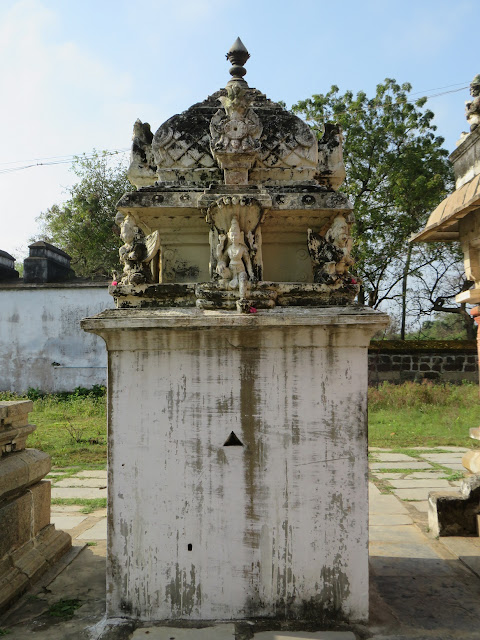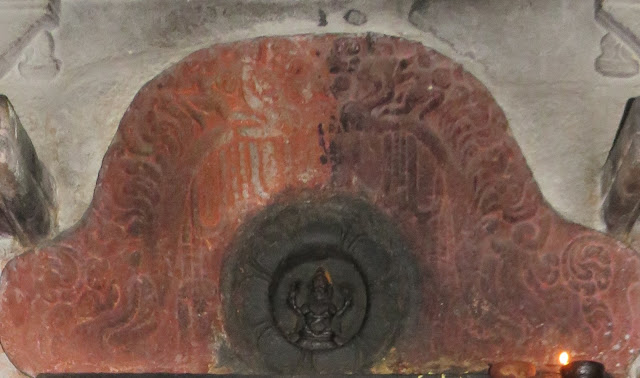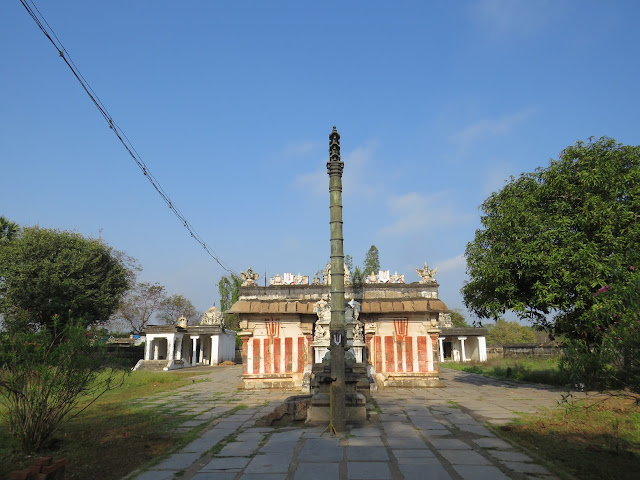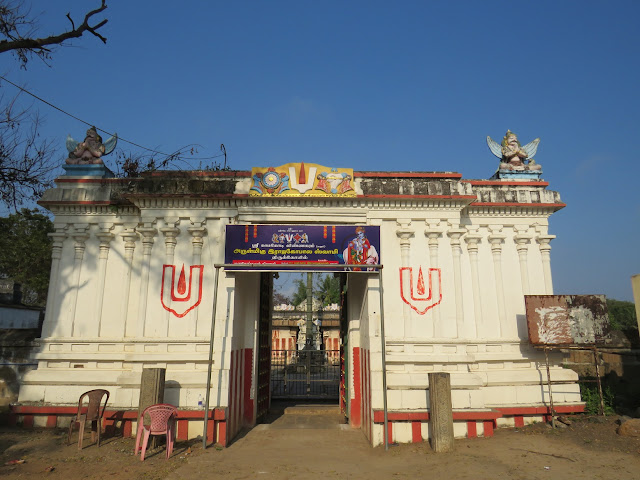Manimangalam Rajagopala Swami Temple
Pulakeshin II was the most illustrious Emperor of the Chalukya Dynasty. Considered the most powerful ruler during his times, he had defeated even two other powerful emperors, Harshavardhana and Mahendravarma Pallava. However, there was an end to his uninterrupted victories. Narasimhavarma Pallava I, a rare Indian ruler who had never experienced a defeat, routed him repeatedly. The Copper Plates of Kuram record the triumph of Narasimha over the Chalukyan army in three places. Manimangalam, a suburb of the current Chennai city, is one of those sites.
This historic battlefield, a quiet village until a few decades ago and a busy developing locality nowadays, is dotted with many temples. Among them, there were three Chola-era Vishnu shrines. One temple was lost without any trace. The second temple is dying fast. The third temple is comparatively famous but hardly has any visitors. This article is about that the third one - Rajagopala Swami Temple.
With the walls studded with innumerable inscriptions, the temple is the delight of heritage enthusiasts. The shrine has so many unbelievable unique features. More than anything, the sculpture of the presiding deity is stunning. If I have to list down the Vishnu temples of the region, this would be the highest on my list. How come people in and around Chennai miss this mesmerizing temple? It is laughable to find someone in the neighborhood who has not yet visited it.
(Note: I have been visiting the temple since 2014. I have curated a heritage trip to this site. I have written about this temple in my blog and book. However, I did not feel accomplished. I thought I should write a notably long article that covers all aspects entirely. Hence, I spent a considerable amount of time collecting details to write this article. I believe this article would be helpful, at least to some extent, to those who are interested in history, heritage and religion. If this article kindles people's interest in regularly visiting this temple, I would be happy.)
Introduction
Highlights
It is a temple full of highlights. In this section, let me briefly touch upon them, as detailed descriptions would follow in the subsequent sections.
Rajagopala Swami, the presiding deity, holds the conch in his right arm and discus in his left arm. It is quite the opposite of other typical Vishnu murtis.
The temple has some of the features that are typically found in Shiva temples. There are five Koshta murtis (niche images) on the outer walls of the main shrine. They include Ganesha and Vishnu Durga. Dakshinamurti's image is found on a torana above a niche. Miniature figures of Shiva Ganas adorn the cornice above the entrance of the Ardha mandapa.
 |
| Bhuta Ganas |
History
None of the inscriptions talks about the temple construction. They all record various gifts granted for temple administration. However, based on the available inscriptions, we could assume that the temple was constructed by Rajaraja Chola I or a former Chola King such as Parantaga Chola II. Besides the original structure by the Cholas, Vijayanagaras have reconstructed/repaired many portions and built a few new shrines.
Right from the Pallava's period, the village has been named Manimangalam. However, the village also had several other names during the reign of various kings.
In the 10th century CE, during the period of Rajaraja Chola I, Manimangalam was also referred to as Ratnagrahara, Ratnagrama and Lokamahadevi Chaturvedi Mangalam.
In the 11th century CE, right from Rajadhiraja Chola's time, the village was also called Rajasulamani Chaturvedi Mangalam.
In the 12th century CE, Kulottunga Chola I started calling the village Pandiyanai Irumadi Venkonda Chola Chaturvedi Mangalam. This name was used till the time of Rajaraja Chola III (13th century CE). Later, the King started mentioning the place as Gramasikhamani Chaturvedi Mangalam.
Chaturvedi Mangalam is the commonly found supplementary name across various times. It indicates that the village was gifted to the priest community, well-versed in four Vedas.
None of the inscriptions call the deity as Rajagopala Swami. In the 10th century CE, he was called Srimad Dvarapuri Deva or Srimad Dvara. The inscription from Rajadhiraja Chola (11th century CE) mentions him as Sri Kamakkoti Vinnagar Alvar. It remains the name of the deity for many years.
Kulottunga Chola II (12th century CE) started calling the deity as Vanduvarapati Emberuman. Kulottunga Chola III used an additional name, Tiruvaykkulattu Emberuman, in just one inscription. As otherwise, Vanduvarapati Emberuman remained the name of God for several years. At last, Rajaraja Chola III calls him Mannanar.
A brief description along with critical information about all the inscriptions can be seen below. Please note that they are listed down in chronological order.
 |
| Mukha Mandapa wall with inscriptions |
Inscription # 1
The inscription is dated in the 6th year of the reign of the Chola King Rajakesarivarman. (I believe it refers to Rajaraja Chola I. If any readers think I am not correct, they can feel free to correct me by providing proof.)
It opens with two Sanskrit verses and the remaining part is in Tamil. It records the grant of 4,000 kuli of land to the temple by a person. He had purchased that land from the inhabitants of the village.
Interestingly, it appears that Manimangalam lake was called Periyaputteri in those days. We could also identify some of the current-era localities mentioned in this inscription, such as Kalichchangal channel (Karasangal), Amanpakkam (Ammanambakkam) and Kulattur (Kolathur).
From this inscription, we understand that Manimangalam was also known as Ratnagrahara, Ratnagrama and Lokamahadevi Chaturvedi Mangalam, and it was a part of Sengattu Kottam (district). The deity was referred to as Srimad Dvarapuri Deva or Srimad Dvara.
Inscription # 2
It is a crucial inscription that gives all the details of Rajadhiraja's military achievements. It lists down all the countries he won over and the kings whom he defeated. It should be noted that the inscription records that the King seized the sister and daughter of Sinhala King Vira Salamegan and cut off the nose of the latter's mother.
From this inscription, we understand that Manimangalam was also known as Rajasulamani Chaturvedi Mangalam, and it was a part of Maganur nadu (sub-division) of Sengattu Kottam (district) in Jayankonda Cholamandalam.
Interestingly, the temple was mentioned as Srimad Dvarapati and the deity was referred to as Sri Kamakkoti Vinnagar Alvar.
Further, the inscription records that the villagers received 100 kasu from the temple treasury and handed over 2,200 kuli of land to the temple.
Inscription # 3
It is a vital inscription that describes Rajendra Chola's victory over the Chalukyan King Ahamavalla (Somesvara I) in the Koppam battle. It also records his victory in Ceylon.
Further, the inscription records that the villagers received money from Kamakkavvaiyal, the mother of Senapati Jayankonda Chola Brahmadhiraja, and granted a piece of land at Amanpakkam (the modern Ammanambakkam, a hamlet near Chenglepet).
The alternate name of the village, the details of Geographical divisions, name of the deity and the temple are all recorded exactly similar to the Inscription #2, as seen above.
Inscription # 4
The lengthy inscription starts with the historic passage of the King's victories over Chalukyas, Pandyas and Keralas. This inscription is one of the reliable source materials to learn the history of Virarajendra Chola.
The alternate name of the village, the details of Geographical divisions, name of the deity and the temple are all recorded exactly similar to the Inscriptions #2 and #3, as seen above.
Further, the inscription records that 4,450 kuli of land near the village were granted to the temple by Senapati Jayankonda Chola Brahmadhiraja. His father had purchased the land from the villagers.
Inscription # 5
Inscription # 6
Inscription # 7
The inscription records the grant of of land to the temple. The land was located in Pulvayppappan Kulattur, evidently the modern-day Kulathur, a nearby hamlet.
It states Manimangalam was also known as Pandiyanai Irumadi Venkonda Chola Chaturvedimangalam and it was a part of Kundrathur nadu (sub-division) of Jayankonda Chola Mandalam (district).
 |
| Garuda's shrine |
Inscription # 8
Inscription # 9
The inscription records the purchase of some land near the village and assignment of same to the temple, with the condition that its produce should be applied for providing offerings of boiled rice to the deity.
It calls Pandyas as Minavars and Cheras as Villavars. It records the queen's name as Mukkokkilanadiga.
It states Manimangalam was also known as Pandiyanai Irumadi Venkonda Chola Chaturvedimangalam and it was a part of Kundrathur nadu (sub-division) of Jayankonda Chola Mandalam (district) alias Kulottunga Chola Valanadu.
Inscription # 10
The inscription records that a military officer purchased 600 kuli of land near the village and assigned it to the temple, with the condition that the produce should be applied for providing offerings of boiled rice to the deity.
From this inscription, we understand that Manimangalam was also known as Pandiyanai Irumadi Venkonda Chola Chaturvedimangalam and it was a part of Kundrathur nadu (sub-division) of Kulottunga Chola Valanadu (district) in Jayankonda Cholamandalam.
The deity was referred to as Vanduvarapati Emberuman and Tiruvaykkulattu Emberuman.
Inscription # 11
Reference - A.R. No. 276 of 1897Location - North Wall of the Main ShrinePeriod - 1197/98 CEKing - Kulottunga Chola IIILanguage - Tamil
Inscription # 12
Reference - A.R. No. 21 of 1896 and South Indian Inscriptions Vol III No. 37Location - East Wall of the Mukha mandapaPeriod - 1207/08 CEKing - Kulottunga Chola IIILanguage - Tamil
The inscription records the grant made to supply fuel for lightening four lamps regularly at the sanctum.
The deity is mentioned as Vanduvarapati and it states that Manimangalam was part of Kunrathur nadu in Jayankonda Cholamandalam.
 |
| Chenkamalavalli Shrine |
Inscription # 13
Reference - A.R. No. 28 of 1896 Location - East Outer Wall of the inner prakaraPeriod - 1225/26 CEKing - Rajaraja Chola IIILanguage - Tamil
It is an incomplete inscription.
Inscription # 14
Reference - A.R. No. 27 of 1896 and South Indian Inscriptions Vol III No. 38Location - East Outer Wall of the inner prakaraPeriod - 1228/29 CEKing - Rajaraja Chola IIILanguage - Tamil
The inscription records the grant of money for two lamps.
From this inscription, we understand that Manimangalam was also known as Pandiyanai Irumadi Venkonda Chola Chaturvedimangalam and was a part of Kundrathur nadu (sub-division) of Kulottunga Chola Valanadu (district), in Jayankonda Cholamandalam.
The deity was referred to as Vanduvarapati Emberuman.
Inscription # 15
Reference - A.R. No. 20 of 1896 and South Indian Inscriptions Vol III No. 39Location - East Wall of the Mukha mandapaPeriod - 1233/34 CEKing - Rajaraja Chola IIILanguage - Tamil
The inscription records that a flight of stone steps leading to mandapa was built at the expense of two brothers from Manimangalam.
The deity was referred to as Vanduvarapati Emberuman.
From this inscription, we understand that Manimangalam was also known as Gramasikhamani Chaturvedi Mangalam. It was a part of Kundrathur nadu (sub-division) Kulottunga Chola Valanadu (district) alias Puliyur Kottam, in Jayankonda Cholamandalam.
Inscription # 16
Reference - A.R. No. 26 of 1896 and South Indian Inscriptions Vol III No. 40Location - East Outer Wall of the inner prakaraPeriod - 1233/34 CEKing - Rajaraja Chola IIILanguage - Sanskrit and Tamil
The inscription consists of a single Sanskrit verse and another verse in Tamil. It records the gift of two lamps to the images of the presiding deity and Singaperumal (Narasimha). (There is just a tiny icon of Narasimha, and no other big sculpture is found in the current temple. Hence, it is unclear if there was a sub-shrine of Narasimha in this temple in those days or the inscription refers to this small image of Narasimha).
From this inscription, we understand that Manimangalam was also known as Gramasikhamani Chaturvedimangalam or Ratnagrahara and the deity was referred to as Mannanar.
Inscription # 17
Reference - A.R. No. 22 of 1896 Location - South Wall of the Mukha mandapaPeriod - 1265/66 CEKing - Jatavarma Sundara Pandya ILanguage - Tamil
It is an incomplete inscription. The identity of the King is debatable.
Inscription # 18
Reference - A.R. No. 274 of 1897 Location - Mukha mandapaPeriod - 1435 CEKing - Devaraya II, Vijayanagara KingLanguage - Tamil
It is a damaged record.
Inscription # 19
Reference - A.R. No. 275 of 1897 Location - South Outer Wall of the Main ShrinePeriod - UnknownKing - UnknownLanguage - Tamil
 |
| Andal Shrine |
Layout
Entrance
Rajagopala Swami
Main Shrine
Koshta Deities
 |
| Ganesha |
 |
| Satya and Nardana Krishna |
 |
| Atchyuta |
 |
| Narasimha |
 |
| Ananta and Kaliya Nardana Krishna |
 |
| Durga and Yoga Vishnu |
Inner Prakara
Mukha Mandapa
 |
| Mukha Mandapa |
Garuda
Chenkamalavalli and Andal
 |
| Chenkamalavalli Vimana |










.JPG)
Nice temple , I have been to this temple. Very well written,keep up the good work.
ReplyDeleteVery well written KK. You writing and its history inspires me to visit this temple.
ReplyDeleteThank you. That's my pleasure.
DeleteThank You Very Much for This Elaborate Temple Tour On Sri Rajagopalaswamy Temple, Manimangalam. Must Visit Temple with Great Heritage 🙏🙏🙏🙏
ReplyDeleteMy pleasure!
DeleteWonderful post, Sir . Very detailed. One observation - the Kostha murtis of Paramapadhanathar and Vishnu Durgai are referred to as facing west. Should this be changed to North?
ReplyDeleteCorrect. That was by mistake. I will correct it in the article now. Thank you.
Delete